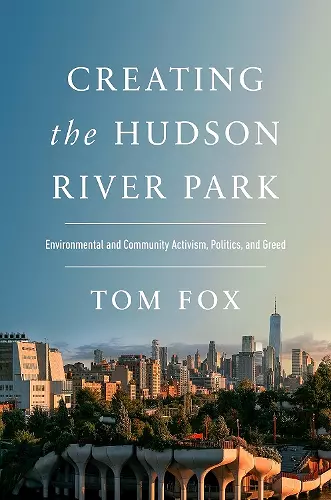Creating the Hudson River Park
Environmental and Community Activism, Politics, and Greed
Format:Hardback
Publisher:Rutgers University Press
Published:12th Apr '24
Currently unavailable, and unfortunately no date known when it will be back

The 4-mile-long, 550-acre Hudson River Park is nearing completion and is the largest park built in Manhattan since Central Park opened more than 150 years ago. It has transformed a derelict waterfront, protected the Hudson River estuary, preserved commercial maritime activities, created new recreational opportunities for millions of New Yorkers, enhanced tourism, stimulated redevelopment in adjacent neighborhoods, and set a precedent for waterfront redevelopment. The Park attracts seventeen million visitors annually. Creating the Hudson River Park is a first-person story of how this park came to be. Working together over three decades, community groups, civic and environmental organizations, labor, the real estate and business community, government agencies, and elected officials won a historic victory for environmental preservation, the use and enjoyment of the Hudson River, and urban redevelopment. However, the park is also the embodiment of a troubling trend toward the commercialization of America’s public parks.
After the defeat of the $2.4 billion Westway plan to fill 234 acres of the Hudson in 1985, the stage was set for the revitalization of Manhattan’s West Side waterfront. Between 1986 and 1998 the process focused on the basics like designing an appropriate roadway, removing noncompliant municipal and commercial activities from the waterfront, implementing temporary improvements, developing the Park’s first revenue-producing commercial area at Chelsea Piers, completing the public planning and environmental review processes, and negotiating the 1998 Hudson River Park Act that officially created the Park. From 1999 to 2009 planning and construction were funded with public money and focused on creating active and passive recreation opportunities on the Tribeca, Greenwich Village, Chelsea, and Hell’s Kitchen waterfronts.
However, initial recommendations to secure long term financial support for the Park from the increase in adjacent real estate values that resulted from the Park’s creation were ignored. City and state politicians had other priorities and public funding for the Park dwindled. The recent phase of the project, from 2010 to 2021, focused on “development” both in and adjacent to the Park. Changes in leadership, and new challenges provide an opportunity to return to a transparent public planning process and complete the redevelopment of the waterfront for the remainder of the 21st-century. Fox’s first-person perspective helps to document the history of the Hudson River Park, recognizes...
“A valuable recounting of a public-private partnership and how to make things work (and why they don't).”
-- Sam Roberts * New York Times *
“Creating the Hudson River Park is important, relevant, and of continuing interest. The revival of Manhattan's west side waterfront, including the bike and jogging paths, the new landscaping, and the revitalized piers has been transformative in the life of the city. An activist, manager, and board member for the entire period he describes, Tom Fox is extremely well qualified to write this story.”
-- Kenneth T. Jackson * author of Crabgrass Frontier: The Suburbanization of the United States *
“Creating the Hudson River Park is an incredibly important story; perhaps at no other time in history was such a significant public work project realized in such a unique way. Tom Fox is uniquely qualified to write this history. He not only had a front row seat for many of the park’s biggest moments, but he was also an active player during many critical phases of the park’s development.”
-- Kevin Bone * author of The New York Waterfront: Evolution and Building Culture of the Port and Harbor *
"The book serves as a very timely reminder that proper scrutiny and public engagement are an important part when using land to benefit the public... The book glows with pride for the achievement made by Fox and the many characters who have orchestrated a beautiful but imperfect urban park." -- Phil O'Brien * W42ST *
“The authoritative account on the creation of our generations most significant addition to the physical city.” -- Kent Barwick * Former President of the Municipal Arts Society and Founding Chairman of the Metropolitan Waterfront *
“Creating the Hudson River Park is a primer on the effectiveness of public participation and how to negotiate a deal for the public good.” -- Robert W. Elliot * Chair, Hudson River Foundation *
ISBN: 9781978814011
Dimensions: 235mm x 156mm x 36mm
Weight: 853g
428 pages